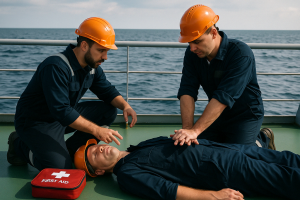Learn why first aid training is vital for seafarers. Discover CPR, wound care, and emergency response protocols tailored to life at sea.
When Every Second Counts
Imagine this: you’re hundreds of miles from shore, and a fellow crew member collapses after a fall. No ambulance, no hospital—just you and your training. In the maritime world, first aid can be the thin line between life and death. Given the remote, high-risk nature of life at sea, first aid training is not just a regulatory formality—it’s an operational necessity.
What Is Maritime First Aid?
Maritime first aid refers to the emergency medical practices adapted for use onboard ships, offshore platforms, and other sea-based operations. This includes everything from CPR and wound care to managing choking or hypothermia—tailored for situations where professional medical help is hours or even days away.
Why It Matters:
-
Ships operate in isolated environments.
-
Medical professionals may not be present.
-
Evacuation is time-consuming and risky.
That’s why the International Maritime Organization (IMO), through the STCW Convention, mandates that all seafarers undergo first aid and medical care training.
Key Components of Maritime First Aid
The ABC of Primary Survey
Before any treatment, seafarers are trained to conduct a Primary Survey, using the ABC approach:
-
A – Airway: Ensure the airway is open. Use the head-tilt and chin-lift technique for unconscious casualties.
-
B – Breathing: Look, listen, and feel for breathing for up to 10 seconds.
-
C – Circulation: Check for signs of severe bleeding and control it immediately.
This structured method ensures life-threatening conditions are identified and treated first.
CPR at Sea: Resuscitation When It Matters Most
Cardio-Pulmonary Resuscitation (CPR) is a cornerstone of emergency response training.
Basic CPR Steps:
-
Compressions: 100–120 per minute, 5–6 cm deep, on the center of the chest.
-
Breaths: 2 rescue breaths for every 30 compressions if trained and able.
-
Continue: Until the casualty recovers or professional help arrives.
Fact: According to the Red Cross, immediate CPR can double or triple survival chances from cardiac arrest.
Wound Care and Bleeding Management
In a shipboard setting, wounds can lead to dangerous infections if not handled properly.
Essential Practices:
-
Cleaning: Use antiseptic solution or saline. Avoid seawater.
-
Dressing: Apply sterile gauze and secure with tape or bandages.
-
Pressure: Stop bleeding by applying direct pressure. Use elevation when appropriate.
Knowing how to improvise with available supplies is also emphasized in maritime training.
Emergency Response for Specific Scenarios
Choking Onboard
- Give up to 5 back blows between the shoulder blades.
- If unsuccessful, proceed to 5 abdominal thrusts.
- Alternate until the object is expelled or the casualty becomes unresponsive.
Drowning Incidents
- Remove from water only if safe to do so.
- Start CPR immediately—don’t waste time checking for a pulse if unresponsive.
- Protect from hypothermia using blankets or dry clothing.
Case Studies: Real-Life First Aid Saves Lives
Case 1: Deep Laceration on a Fishing Vessel
A crew member slashed their hand on a fish-cleaning knife. The first responder cleaned the wound, applied pressure, and used a tourniquet until the bleeding stopped—preventing critical blood loss until shore assistance.
Case 2: Heat Exhaustion on a Sailing Yacht
During an inter-island journey, a deckhand became disoriented from dehydration. Quick identification of symptoms led to shade, cold compresses, and oral rehydration—averting heat stroke.
These incidents underscore the power of preparedness and confident application of first aid training.
Ongoing Training: Keeping Skills Sharp
First aid isn’t a “once-and-done” skill—it requires continuous learning and drills.
Best Practices:
-
Conduct monthly drills with real scenarios.
-
Include STCW refresher courses.
-
Update medical kits and first aid manuals onboard.
-
Keep a log of crew members’ medical conditions and allergies.
Regular updates ensure that seafarers respond instinctively in emergencies.
FAQs: People Also Ask
Why is first aid training important for seafarers?
Because ships operate in remote areas without immediate access to hospitals, trained crew can provide critical care before professional help is available.
Is first aid part of the STCW training?
Yes. STCW requires all seafarers to undergo approved basic first aid training.
How often should maritime first aid training be renewed?
Refresher training is recommended every five years, as per STCW guidelines, or sooner if operating in high-risk zones.
What should be in a ship’s medical kit?
Sterile dressings, antiseptics, scissors, bandages, CPR mask, gloves, medication for seasickness, painkillers, and burn treatment supplies.
Conclusion: Preparedness Protects Lives
Whether you’re sailing across the globe or navigating coastal waters, one fact remains: first aid saves lives. It empowers seafarers to act confidently during medical crises, prevents complications, and buys critical time until help arrives.
🚢 Call to Action:
If you’re part of a maritime team—captain, engineer, or cadet—invest in STCW-certified first aid training, hold regular drills, and stay informed. You never know when your skills will be the difference between life and death.


